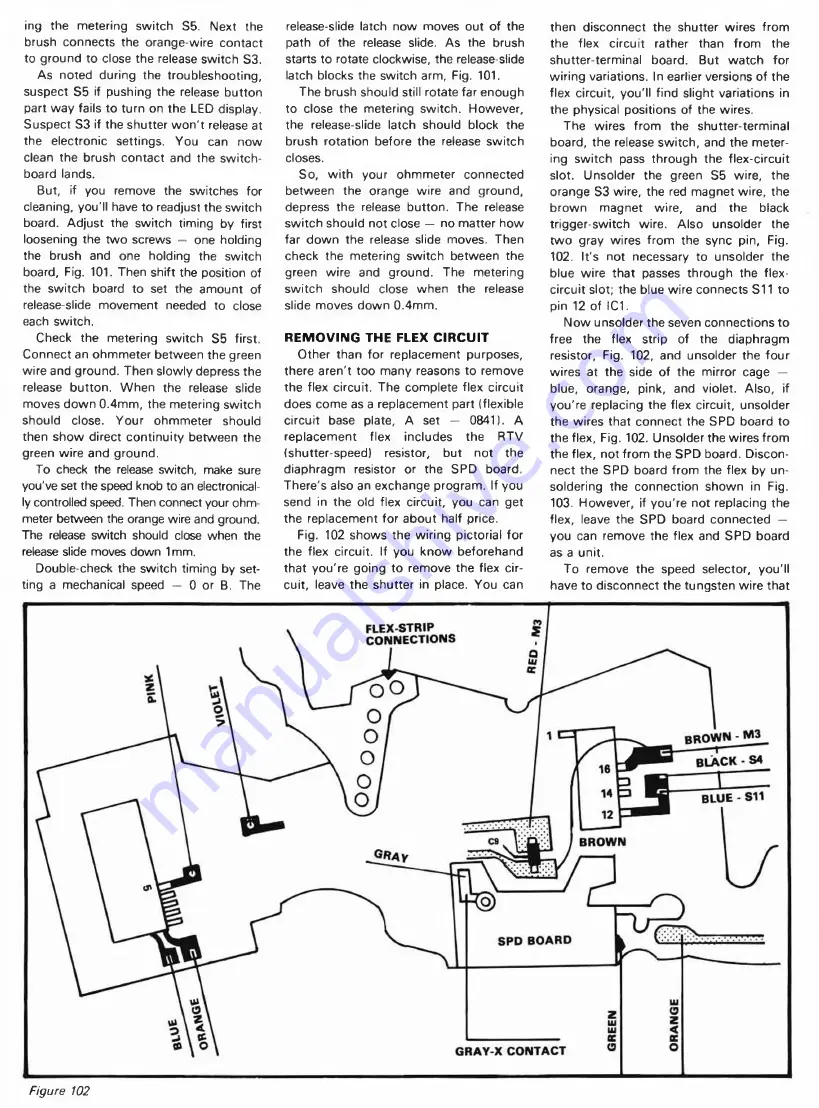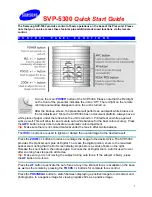
ing the metering switch S5. Next the
brush connects the orange-wire contact
to ground to close the release switch S3.
As noted during the troubleshooting,
suspect S5 if pushing the release button
part way fails to turn on the LED display.
Suspect S3 if the shutter w o n 't release at
the electronic settings. You can now
clean the brush contact and the sw itch
board lands.
But, if you remove the switches for
cleaning, you'll have to readjust the switch
board. Adjust the switch timing by first
loosening the tw o screws — one holding
the brush and one holding the switch
board, Fig. 101. Then shift the position of
the switch board to set the amount of
release-slide movement needed to close
each switch.
Check the metering switch S5 first.
Connect an ohmmeter between the green
wire and ground. Then slowly depress the
release button. When the release slide
moves down 0.4mm, the metering switch
should close. Your ohmmeter should
then show direct continuity between the
green wire and ground.
To check the release switch, make sure
you've set the speed knob to an electronical
ly controlled speed. Then connect your ohm
meter between the orange wire and ground.
The release switch should close when the
release slide moves down 1 mm.
Double-check the switch timing by set
ting a mechanical speed — 0 or B. The
release-slide latch now moves out of the
path of the release slide. As the brush
starts to rotate clockwise, the release-slide
latch blocks the switch arm, Fig. 101.
The brush should still rotate far enough
to close the metering switch. However,
the release-slide latch should block the
brush rotation before the release switch
closes.
So, w ith your ohmmeter connected
between the orange wire and ground,
depress the release button. The release
switch should not close — no matter how
far down the release slide moves. Then
check the metering switch between the
green wire and ground. The metering
switch should close when the release
slide moves down 0.4mm.
REMOVING THE FLEX CIRCUIT
Other than for replacement purposes,
there aren't too many reasons to remove
the flex circuit. The complete flex circuit
does come as a replacement part (flexible
circuit base plate, A set — 0841). A
replacement flex includes the RTV
(shutter-speed) resistor, but not the
diaphragm resistor or the SPD board.
There's also an exchange program. If you
send in the old flex circuit, you can get
the replacement for about half price.
Fig. 102 shows the wiring pictorial for
the flex circuit. If you know beforehand
that you're going to remove the flex cir
cuit, leave the shutter in place. You can
then disconnect the shutter wires from
the flex circuit rather than from the
shutter-terminal board. But watch for
wiring variations. In earlier versions of the
flex circuit, you'll find slight variations in
the physical positions of the wires.
The wires from the shutter-terminal
board, the release switch, and the meter
ing switch pass through the flex-circuit
slot. Unsolder the green S5 wire, the
orange S3 wire, the red magnet wire, the
brown magnet wire, and the black
trigger-switch wire. Also unsolder the
tw o gray wires from the sync pin, Fig.
102. It's not necessary to unsolder the
blue w ire that passes through the flex-
circuit slot; the blue wire connects S11 to
pin 12 of IC1.
Now unsolder the seven connections to
free the flex strip of the diaphragm
resistor, Fig. 102, and unsolder the four
wires at the side of the mirror cage —
blue, orange, pink, and violet. Also, if
you're replacing the flex circuit, unsolder
the wires that connect the SPD board to
the flex, Fig. 102. Unsolder the wires from
the flex, not from the SPD board. Discon
nect the SPD board from the flex by un
soldering the connection shown in Fig.
103. However, if you're not replacing the
flex, leave the SPD board connected —
you can remove the flex and SPD board
as a unit.
To remove the speed selector, you’ ll
have to disconnect the tungsten wire that
FLEX-STRIP
C O N N E C TIO N S
B R O W N - M 3
B L A C K - S4
SP D B O A R D
G R A Y -X C O N T A C T
Figure 102












































